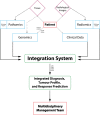Radiomics: a critical step towards integrated healthcare
- PMID: 30421396
- PMCID: PMC6269340
- DOI: 10.1007/s13244-018-0669-3
Radiomics: a critical step towards integrated healthcare
Abstract
Medical imaging is a vital part of the clinical decision-making process, especially in an oncological setting. Radiology has experienced a great wave of change, and the advent of quantitative imaging has provided a unique opportunity to analyse patient images objectively. Leveraging radiomics and deep learning, there is increased potential for synergy between physicians and computer networks-via computer-aided diagnosis (CAD), computer-aided prediction of response (CARP), and computer-aided biological profiling (CABP). The ongoing digitalization of other specialties further opens the door for even greater multidisciplinary integration. We envision the development of an integrated system composed of an aggregation of sub-systems interoperating with the aim of achieving an overarching functionality (in this case' better CAD, CARP, and CABP). This will require close multidisciplinary cooperation among the clinicians, biomedical scientists, and (bio)engineers as well as an administrative framework where the departments will operate not in isolation but in successful harmony. KEY POINTS: • The advent of quantitative imaging provides a unique opportunity to analyse patient images objectively. • Radiomics and deep learning allow for a more detailed overview of the tumour (i.e., CAD, CARP, and CABP) from many different perspectives. • As it currently stands, different medical disciplines have developed different stratification methods, primarily based on their own field-often to the exclusion of other departments. • The digitalization of other specialties further opens the door for multidisciplinary integration. • The long-term vision for precision medicine should focus on the development of integration strategies, wherein data derived from the patients themselves (via multiple disciplines) can be used to guide clinical decisions.
Keywords: Deep learning; Healthcare systems; Integrated systems; Quantitative imaging; Radiomics.
Figures


References
-
- Segal E, Sirlin CB, Ooi C et al (2007) Decoding global gene expression programs in liver cancer by noninvasive imaging. Nat Biotechnol 25(6):675–680. 10.1038/nbt1306 - PubMed
LinkOut - more resources
Full Text Sources
Research Materials
Miscellaneous

